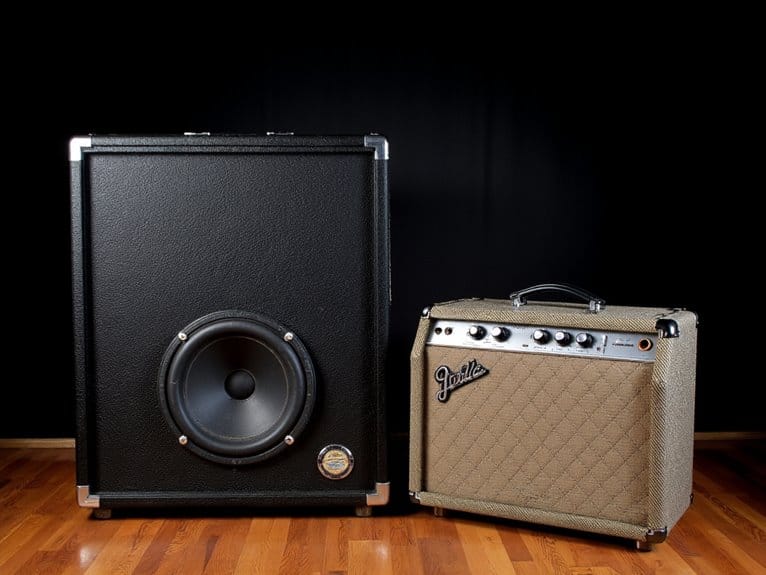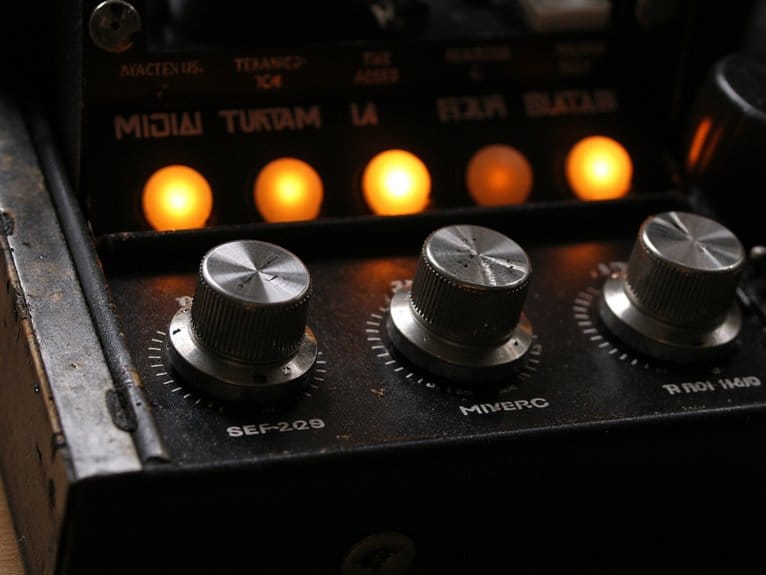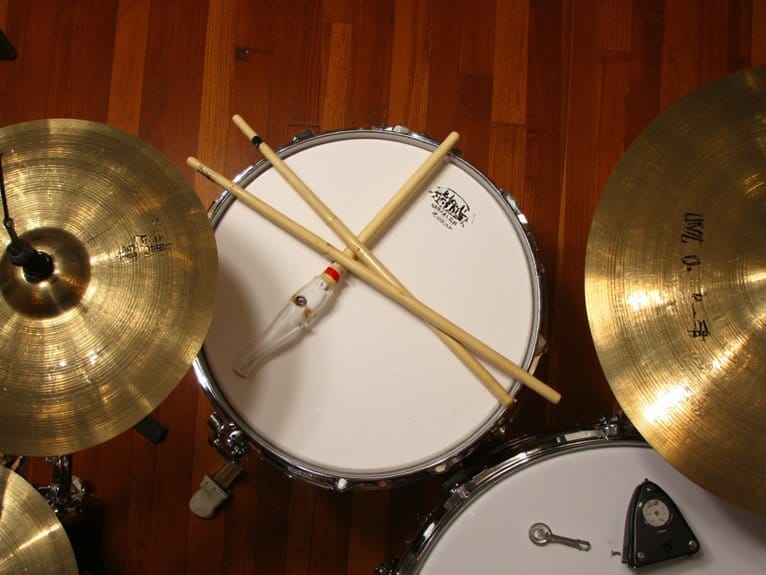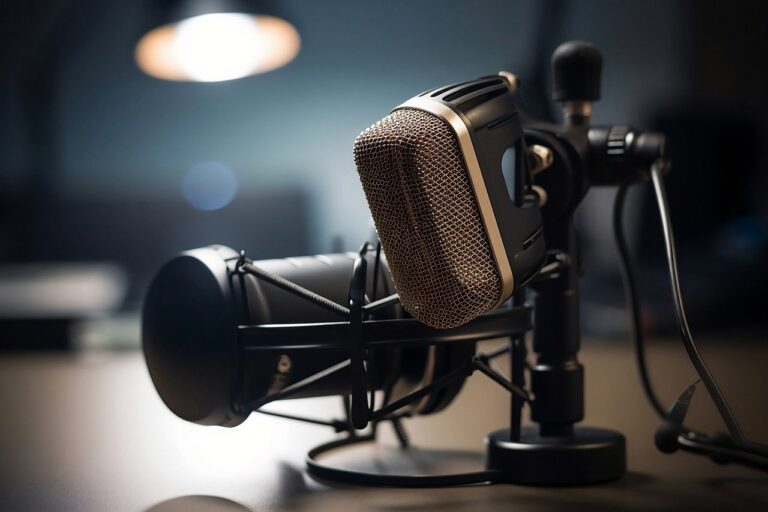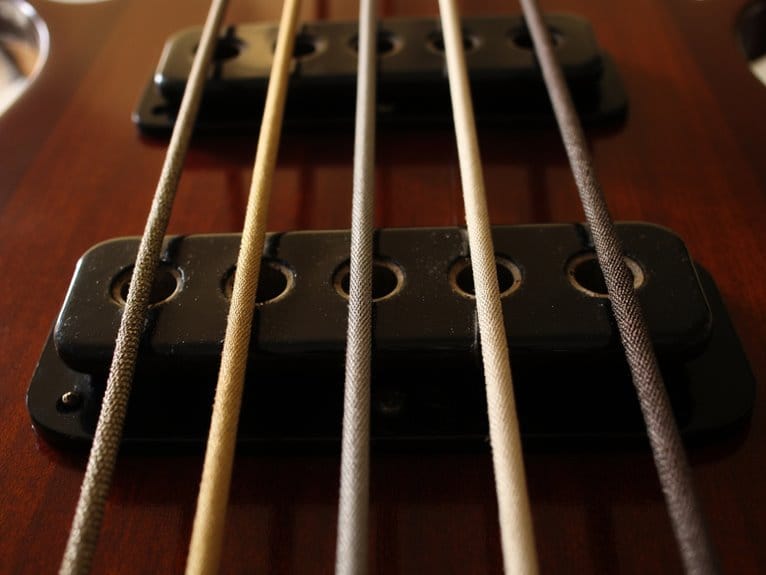Bass Amplifiers Vs Guitar Amps: Key Differences Explained
You’ll find that bass amps pack considerably more power, typically requiring 300-1,000 watts compared to guitar amps’ 15-100 watts, since bass frequencies demand 8-10 times more energy for equivalent volume perception. Bass cabinets use larger 10″-15″ speakers in configurations like 4×10″ or 2×15″, while guitar amps favor 8″-12″ speakers in 1×12″ or 4×12″ setups, with bass amps focusing on clean headroom and guitar amps emphasizing tonal versatility and distortion capabilities—though these fundamental differences reveal much deeper engineering distinctions.
We are supported by our audience. When you purchase through links on our site, we may earn an affiliate commission, at no extra cost for you. Learn more.
Notable Insights
- Bass amps require 8-10 times more wattage (300-2000W) than guitar amps (15-100W) to produce equivalent volume levels.
- Bass amps use larger speakers (10″-15″) in bigger cabinets, while guitar amps typically use smaller speakers (8″-12″).
- Bass amps focus on 30Hz-4kHz frequency range; guitar amps target 80Hz-7kHz with more extensive EQ options.
- Bass amps prioritize clean headroom and low-end clarity, while guitar amps enhance distortion and midrange harmonics.
- Bass amps feature heavier construction with reinforced bracing and larger transformers to handle high-wattage operations.
Power Output and Wattage Requirements
When it comes to amplification, the fundamental difference between bass and guitar amps lies in their power requirements, and honestly, the gap is pretty dramatic.
You’ll find that typical guitar amps run comfortably between 15 to 100 watts, while bass amps usually start around 300 watts and can climb well beyond 1,000 watts.
This isn’t just manufacturers showing off – bass frequencies demand considerably more energy because your ears perceive low-end less efficiently than mids and highs.
The wattage requirements translate to bass amps needing roughly 8-10 times more power than guitar amps for equivalent output.
Bass amplifiers require approximately 8-10 times more wattage than guitar amps to achieve the same perceived volume output.
Superior power handling guarantees your bass cuts through the mix without distortion, maintaining clarity that weaker amplification simply can’t deliver. Your ear exhibits greater sensitivity to frequencies between 1-3 kHz, which explains why guitar amplification appears more efficient at lower wattages. High-end bass amp models can exceed 2000 watts, ensuring sound quality in larger venues.
Speaker Size and Cabinet Configuration
Two fundamental aspects separate bass and guitar amplification more distinctly than speaker size and cabinet configuration, and I’ll admit the differences are more nuanced than you might expect. Your bass requires speakers that handle low-frequency extension, while your guitar needs midrange clarity and harmonic response. Speaker sensitivity varies dramatically between applications, affecting how efficiently each converts power into sound. Cabinet design influences tonal balance considerably, with bass systems favoring multiple smaller drivers for punch and single larger ones for warmth.
| Aspect | Bass Amplifiers | Guitar Amplifiers |
|---|---|---|
| Common Speaker Sizes | 10″, 15″ | 8″, 10″, 12″ |
| Popular Configurations | 4×10″, 1×15″, 2×15″ | 1×12″, 2×12″, 4×12″ |
| Frequency Emphasis | Low-end extension, clarity | Midrange presence, harmonics |
| Cabinet Purpose | Power projection, definition | Tonal complexity, breakup characteristics |
| Design Priority | Surface area, transient response | Voice coil responsiveness, sustain |
Frequency Response and EQ Design
Beyond the physical differences in speaker arrangements and cabinet designs, the electronic heart of these amplifiers reveals even more considerable distinctions in how they process and shape sound frequencies.
Bass amps handle an entirely different frequency spectrum than guitar amps, which fundamentally changes how you’ll experience their tonal nuances and frequency specific effects.
Here’s how these amplifiers differ in their electronic design:
- Frequency Range: Bass amps cover 30 Hz to 4 kHz, while guitar amps focus on 80 Hz to 7 kHz.
- EQ Complexity: Guitar amps offer extensive EQ options; bass amps provide simpler, focused controls.
- Power Requirements: Bass frequencies demand considerably higher wattage for clean reproduction.
- Effects Integration: Guitar amps emphasize reverb and delay; bass amps prioritize clean headroom over effects.
Guitar amplifiers also incorporate power attenuators to achieve tube saturation and natural overdrive at lower volumes, a feature that’s particularly valuable for practice sessions and apartment recording scenarios.
Physical Build and Construction Differences
The sheer mass difference between bass and guitar amplifiers becomes immediately apparent when you’re lugging gear to your first gig, and I’ll admit I underestimated this reality until my back reminded me otherwise.
Bass amps require substantially more robust construction, with cabinet materials like thick wood panels and reinforced internal bracing to handle powerful low-frequency vibrations without unwanted resonance. You’ll find 10-to-15-inch speakers demanding larger, heavier enclosures compared to guitar amps’ typical 8-to-12-inch configurations.
Speaker efficiency becomes essential in bass applications, often utilizing ported designs or horn-loaded cabinets to maximize low-end projection. The electronics inside also reflect this heavy-duty approach, with larger transformers, extensive heat sinks, and rugged power supplies built to sustain high-wattage operation without compromising stability or clarity.
While gigging musicians prioritize portability, bass amp manufacturers have responded with lightweight alternatives that maintain reinforced wood construction to prevent damage during transportation while reducing overall weight through advanced materials and design optimization. Professional bass amps often incorporate metal chassis and reinforced corners to ensure reliability during the rigors of frequent transport and live performance demands.
Tone Quality and Sound Characteristics
Nothing reveals the fundamental differences between bass and guitar amplifiers quite like plugging your instrument into the wrong one, and I’ve learned this lesson the hard way more than once.
The tone clarity and sound dynamics between these amplifiers stem from their distinct frequency prioritization approaches, which directly impact their genre suitability and performance enhancement capabilities.
- Frequency Response: Bass amps emphasize 40-400 Hz for deep fundamentals, while guitar amps focus on 80 Hz-5 kHz for midrange articulation and note definition.
- Harmonic Content: Guitar amps enhance distortion for tonal versatility, whereas bass amps prioritize clean headroom to maintain clarity in ensemble settings.
- Attack Characteristics: Bass amps handle strong transients smoothly, while guitar amps often add intentional coloration through tube circuits.
- EQ Philosophy: Bass amps use multi-band controls for precise shaping, guitar amps employ simpler tone stacks emphasizing essential midrange frequencies. Effective EQ controls allow musicians to shape their sound across different frequency ranges, whether using basic 3-band configurations or more sophisticated multi-band systems.
Similar to how flute material composition affects tone production and sound quality, amplifier construction materials and circuitry design fundamentally shape the sonic characteristics of both bass and guitar amplifiers.
Cross-Compatibility and Usage Scenarios
You’ve probably wondered whether you can plug your guitar into that bass amp sitting in the corner, or conversely, whether your bass will work through a guitar amplifier in a pinch.
While cross-compatibility between bass and guitar amps is technically possible, the results vary dramatically depending on which direction you’re going, and I’ll be honest—most of these scenarios involve significant compromises in tone quality and potential equipment risks.
Understanding when and how to safely use bass amps with guitars, guitars with bass amps, and the practical guidelines that govern these situations can save you from both sonic disappointment and costly equipment damage.
Bass Through Guitar Amps
Here’s what happens when you use a bass through a guitar amp:
- Frequency response drops dramatically – Guitar amps only handle frequencies down to 80 Hz, missing bass fundamentals around 20 Hz.
- Sound becomes thin and harsh – Lack of low-end support compromises the bass’s natural fullness.
- Equipment damage risks increase – High-volume bass playing can permanently damage guitar speakers.
- Performance scenarios become unusable – Only suitable for quiet practice sessions.
Guitar Through Bass Amps
Unlike running bass through guitar amps, which typically ends in disappointment or speaker damage, plugging your guitar into a bass amp presents a much safer scenario with some surprisingly useful applications.
You’ll notice your guitar tones become warmer and cleaner, though you might sacrifice some midrange presence that defines traditional guitar sounds. The higher wattage provides incredible headroom, meaning you’ll get crystal-clear tones even at volumes that would make your neighbors question your sanity.
While tonal clarity might suffer due to the bass amp’s frequency emphasis, many players exploit this characteristic to create unique textures for ambient or experimental music. Adjusting your amp settings becomes essential—you’ll need to boost mids and highs while taming the low-end to achieve balanced guitar tones.
Practical Usage Guidelines
When considering cross-compatibility between bass and guitar amplifiers, I’ve found that understanding the fundamental frequency differences becomes essential for making informed decisions about your setup.
Bass amps generally handle guitar signals cleanly due to their robust low-frequency design, while guitar amps risk speaker damage when pushed with bass frequencies that demand excessive cone excursion.
Here are four practical guidelines I recommend:
- Use bass amps for guitar practice – They provide clean, powerful sound without requiring separate equipment.
- Adjust parametric EQ settings – Fine-tune mid-frequency ranges to approximate guitar amp characteristics.
- Pair with guitar-specific preamps – Combine bass amps with tone shaping pedals for desired guitar tones.
- Consider amp modifications carefully – Vintage models like Fender Bassman offer natural versatility for both instruments.
Performance Features and Professional Applications
When you’re weighing bass amps against guitar amps for professional use, you’ll find that each type excels in specific performance scenarios that directly impact your sound quality and equipment reliability.
Whether you’re tracking in a studio where clean, powerful low-end reproduction matters most, performing live where your bass needs to cut through a full band mix, or connecting to professional audio systems that demand specific input/output configurations, the amplifier you choose becomes essential to your success.
I’ve seen too many bassists struggle with inadequate guitar amps during vital gigs, while guitarists who understand their amp’s limitations rarely face the same frequency-related challenges that plague mismatched bass setups.
For beginners starting their journey, entry-level amps between $100 and $300 can deliver professional sound quality without the excessive costs of high-end equipment.
Live Performance Requirements
While you might think that any amplifier can handle a live gig, the reality is that bass amps face notably different challenges than guitar amps when it comes to cutting through the mix during performances.
Bass amplification requires considerably more power, typically demanding 100+ watts compared to guitar amps that often peak around 100 watts, because low frequencies need substantial energy to maintain clarity against drums and other instruments.
Understanding these gig necessities becomes vital when you’re selecting equipment that won’t leave you buried in the mix. Guitar amplifiers under this wattage range, such as those with 25-watt power sections, are typically better suited for apartment use and practice rather than live performance venues.
Here are the key live performance requirements that separate bass from guitar amplification:
- Power Output: Bass requires 30-200 watts for small to large venues
- Class AB Circuitry: Provides superior dynamic response over Class D alternatives
- Built-in DI Outputs: Essential for front-of-house sound reinforcement
- Amplifier Reliability: Durable construction for prolonged high-volume use
For musicians seeking additional amplification flexibility, power amp pedals can provide clean amplification ranging from 2.5 to over 200 watts, making them valuable additions to modern bass rigs.
Studio Recording Applications
Recording environments transform the amplifier equation entirely, shifting priorities from raw stage power to nuanced tonal sculpting and signal chain flexibility.
You’ll find bass amps prioritize low-frequency clarity through extended EQ controls, while guitar amps emphasize midrange harmonics with multiple gain stages for tonal coloration.
Modern recording techniques heavily rely on DI inputs combined with amp simulation plugins, allowing you to blend pristine direct signals with virtual Ampeg SVTs or Marshall stacks during mixing.
Studio mixing strategies often favor bass amp models with blend functions that preserve fundamental frequencies when adding effects, whereas guitar amp simulations focus on harmonic content and spatial qualities.
Professional workflows integrate both approaches, giving you unprecedented control over your final recorded tone through precise digital modeling.
Professional Connectivity Options
Beyond the controlled environment of the studio, professional bass amplifiers distinguish themselves through sophisticated connectivity architectures that guitar amps rarely match, reflecting the bass’s foundational role in live sound reinforcement and signal distribution.
Your bass amp’s professional connectivity options create seamless integration with complex audio chain setups, offering signal routing flexibility that guitar amplifiers simply don’t prioritize:
- XLR balanced outputs provide clean, interference-free connections to PA systems with configurable pre- or post-EQ settings.
- USB digital connectivity enables simultaneous computer recording while feeding live monitors and front-of-house systems.
- Multiple output configurations allow you to split signals across different destinations without additional DI boxes.
- Integrated effects loops let you insert external processors while maintaining signal integrity throughout your performance setup.
This performance flexibility reflects how bassists anchor both rhythmic foundations and technical requirements in professional environments. Professional bass amplifiers often feature phantom power capabilities for direct condenser microphone integration, expanding their utility beyond traditional instrument amplification. While portable guitar amplifiers focus on battery life optimization for practice sessions, professional bass amps prioritize comprehensive connectivity solutions that support extended live performance demands.
Frequently Asked Questions
Can I Use Effects Pedals Designed for Guitar With Bass Amplifiers?
You can use guitar effects pedals with bass amplifiers, though effects compatibility varies by pedal type. Careful pedal selection is essential since some guitar pedals may reduce low frequencies, requiring EQ adjustments to maintain your bass tone.
On a final note
You’ll need to match your amplifier to your instrument for ideal performance, as these differences aren’t just technical preferences—they’re fundamental design requirements. While you can occasionally use guitar amps for bass in quiet practice scenarios, you’re risking speaker damage and compromising tone quality. I’d recommend investing in the proper amplifier for your instrument, since the specialized engineering behind each type delivers considerably better results than any cross-compatibility attempts.

